Link builders have a tough job. They have to find a way to build links for their websites and their clients without putting them at risk of a Google penalty. While Google stresses the importance of natural links earned by producing great content, anyone who does a little competitive research knows that competitors who rank on the first page of search does a little more than just that.
In this post, I am going to look at how you can get more links that count in a Google-friendly manner by focusing on quality over quantity.
Step 1: Know Your Competitors
When it comes to link building, your competitors are the webpages that rank ahead of you in search results. In some cases, your competitors may not be your competitors in business, but just your competitors in search. For example, most businesses are not competing with Wikipedia. But if Wikipedia has a page that ranks for a keyword you are targeting, then they are your competitors in search.
To get started, you will need to list the top keywords you want to rank for. For example, if you have a website that is an online degree directory, you may have a keyword list that includes “online degree programs”. So, you will want to go to Google and search for online degree programs (removing personalized results) to see the sites that rank above you.
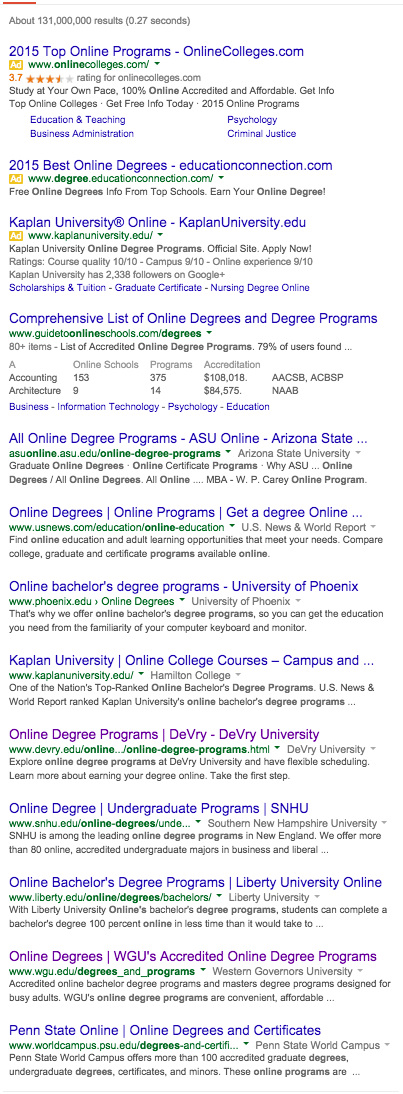
Here, you can see sites similar to yours, as well as actual university online degree programs. These are all your competitors in search. Why? Because they are all websites you want to outrank. While outranking a university is going to be tough, those universities likely have some quality backlinks you may be able to acquire.
Step 2: Find Your Search Competitors’ Best Links
Using a tool like Link Assistant, (one of my former freelance writing clients) you can find link partners that link to your competitors by creating a project for your website and entering the websites that rank ahead of you in search as competitors.
Here’s an example walk-through of this tool specifically, though many tools like this work the same:
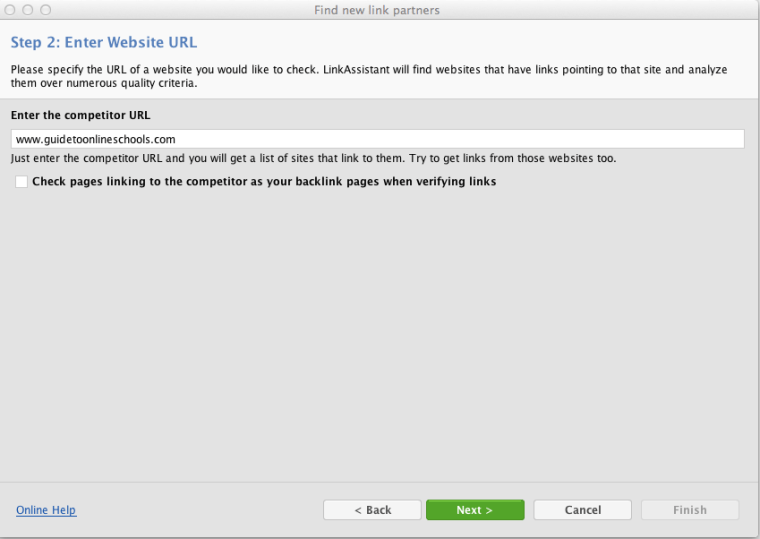
You will find the top 30 potential link opportunities based on their MozRank.
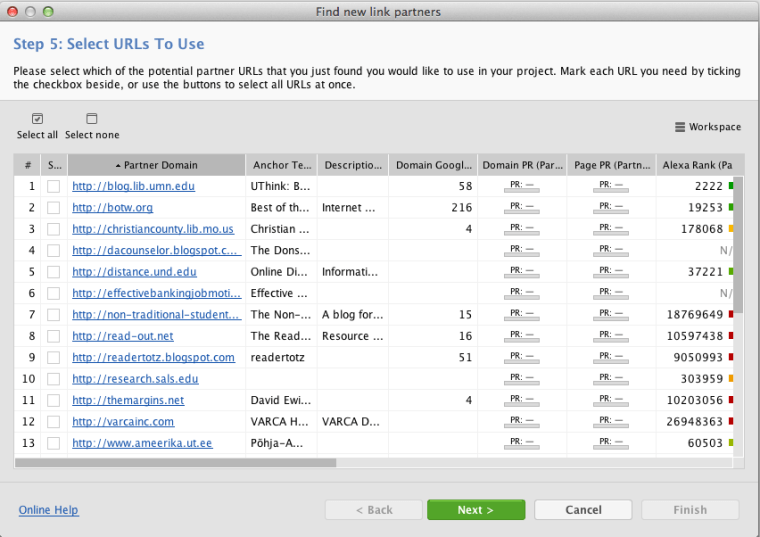
In addition to Mozrank, it will also show you the Alexa rank, domain age, number of pages they have indexed in Google, and number of social shares on the top networks (Facebook, Twitter, etc.).
From here, you can continue to add your search competitors to see the top backlinks they have and add them to your potential link partners list. Once you’ve added the top backlinks for several of your search competitors, you can go to your Partner Details tab to sort all of the opportunities by the criteria you are most interested in.
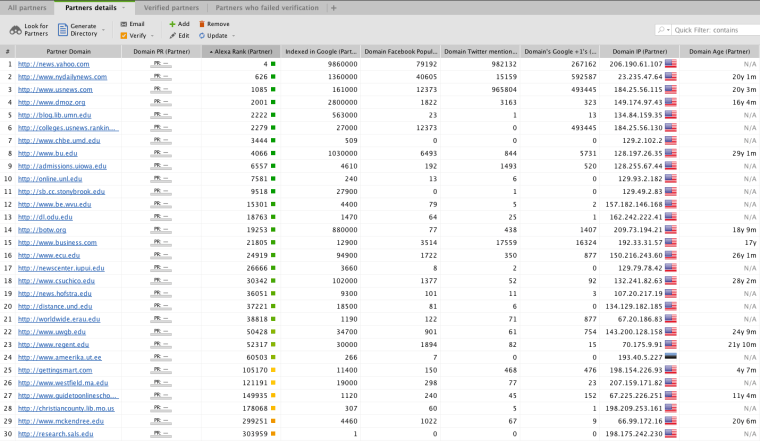
For example, if you want to get links on the sites that get the most traffic, you can sort the Alexa column. Sort in ascending order, as the lowest value represents the sites with the highest estimated traffic.
What you now have is the cream of the crop in terms of link partner opportunities. The more search competitors you enter into your project, you will find more high quality link opportunities.
Step 3: Check for Google Penalties
For those who want to fully ensure a link opportunity is of the highest of quality, you can do a quick – and free – check of the domain for Google algorithm hits using a tool like the Website Penalty Indicator. This tool allows you to enter a domain and see its estimated search traffic, along with markers of major Google updates.
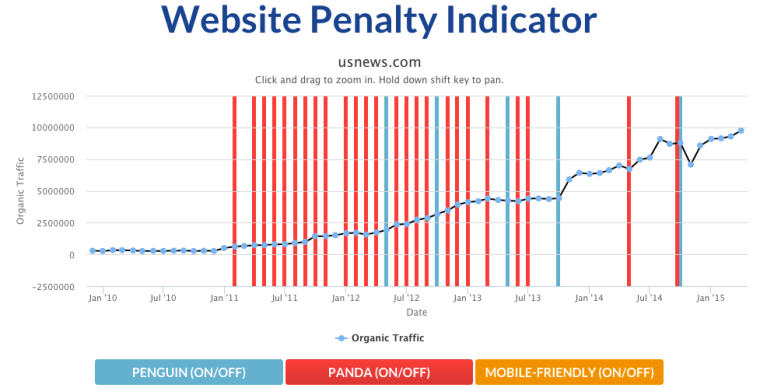
When should you consider a link opportunity not worth it in terms of a search engine traffic dip? When it is directly related to a Google algorithm change and the site has not recovered their traffic, as shown in the following example.
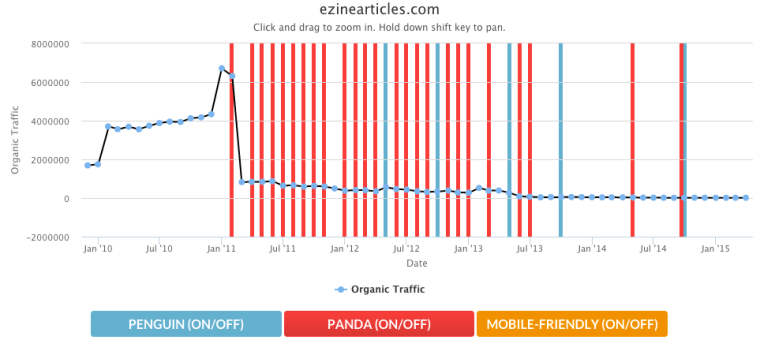
This website’s organic search traffic has consistently declined since they were hit by the original Google Panda update in 2011. Therefore, a link from this site would likely not be considered good from Google’s point of view.
Step 4: Evaluate Opportunities Closely
Here’s what separates quality link builders from spam link builders. Spammers would look at these opportunities and send out a blanket template email to all of them, asking for a link.
Quality link builders, on the other hand, are going to evaluate these link opportunities.
Here’s what you might find when you evaluate some of your top link opportunities.
- Your competitor obtained the link by submitting their website to a specific category in the website’s directory.
- Your competitor obtained the link by submitting a great piece of content to the website’s blog.
- Your competitor obtained the link by creating a profile in the website’s community.
- Your competitor obtained the link by sharing a quote, fact, or statistic to support content on a specific page on the website.
- Your competitor obtained the link by posting a job listing on a high authority domain.
- Your competitor obtained the link by offering the website a unique piece of content, such as a tool, badge, or other resource that related to a specific page’s content.
- Your competitor obtained a link that you will likely not be able to get due to a difference in website or specific partnership. However, the website offers other link opportunities such as a directory, blog, community profile, or resource page.
The point is, none of the above scenarios can be handled with a simple link request template. Sending a generic “Please link to me” email will likely end with your email getting moved to the spam folder. Each of these scenarios require you to go down a different avenue to obtain a link similar to the one your competitor has.
Step 5: Analyze Your Competitor’s Link In-Depth
There are a few things you need to analyze about your competitor’s link:
- What page the competitor’s link is placed on.
- Where the link is placed on the page.
- What content supplements the link.
- Where the link goes on the competitor’s website.
- The recency of the link placement.
For example, you may find that your competitor has a link on Amazon. Upon further research, you may find that the link is within their Askville community.
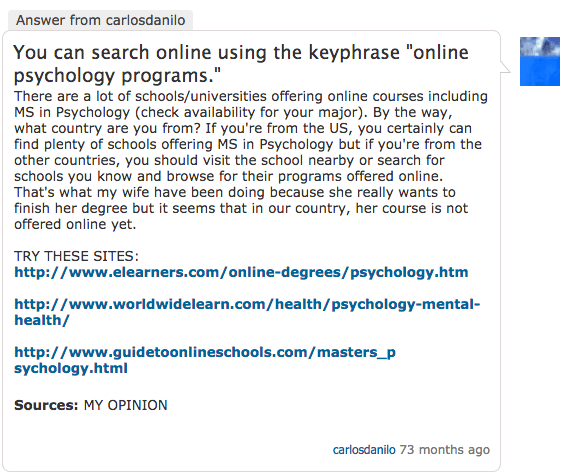
What you can learn here is that someone submitted an answer to a question in Amazon’s community and linked to a specific page your competitor’s website. To add value, they included links to other competitors, meaning that a link builder could have done this for your competitor in a way that makes it look like a knowledgeable member of the community did it. You will likely be able to obtain a similar link for yourself, but first you will need to find some good questions in the community where your link would be a relevant source for an answer.
In the next example, you may find that your competitor has a link on ATT.com. Upon further research, you may find that the link is on a resource page on a subdomain.
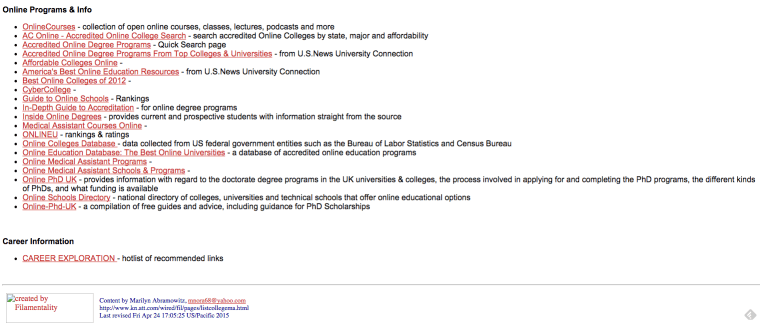
At the bottom, you will find that a specific person maintains this page and has updated it within the last 30 days. So instead of using the email address for the main domain, you will now have a specific name and email address to contact to get your website link on this page along with your competitor’s.
In the final example, let’s say you find your competitor has a link on US News. Upon further research, you may find the link is a resource within the article.
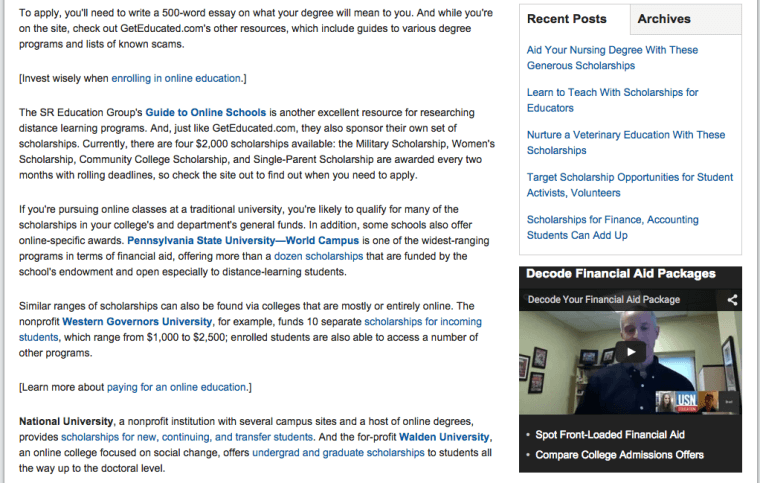
Your competitor obtained this link for two reasons: one, because they have a useful resource, and two, they offer scholarships. Their scholarships page is the one that is linked to in the article.
Hence, if you want to get a similar link in this article or a future one, your website would have to be a valuable resource for researching distance learning and fund a scholarship.
Step 6: Create Custom Content
Now is the fun part. You need to create custom content that helps get your website link placed with the highest quality link opportunities your competitors obtained. You may think a directory listing is just a directory listing or a community profile is just a community profile, but the truth is, there are good ones that will encourage a visitor to click on your link and bad ones that will encourage them to move along.
If you want to get specific links, you will need to create content for directory listings, profiles, and blogs. You will need to do some research and come up with interesting facts and statistics that can be attributed to you. You will need to create great tools, banners, images, and video that people want to share.
Effectively, you need to create better content than your competitor. The objective isn’t necessarily to steal your competitor’s links, but to rather give an additional resource (and hopefully better resource). It may be something as simple as creating a longer, more thorough guide on a specific topic. Or creating a better-designed calculator. Or creating a more streamlined template. You don’t have to reinvent the wheel in most cases – you just have to improve upon it.
Step 7: Obtain the Link
Once you have your link opportunities lined up and you’ve created the right kind of content for each, it’s time to start obtaining your links. Directories, community profiles, Q&A sites, and forums don’t require outreach – just start submitting your information as directed on each site.
For link opportunities through guest blogging, you will want to make sure you don’t sound like every other guest blogger (or worse, link spammer) requesting to contribute content to the website. The three things that separate a bad guest blogging request and a good one are as follows.
- Personalizing the email in the form of addressing a specific blog owner or editor by name.
- Demonstrating you have thoroughly gotten to know the blog. Something to the effect of “I just finished reading your guest post guidelines, and would love to contribute a 1,500 word post on [something that matches the topics in the guidelines].”
- Expressing interest in being more than just a one-off guest blogger. Many sites are now asking for people to be regular contributors. Some go so far as only giving nofollow links to one-time guest bloggers.
For link opportunities through creating custom resources (tool, app, guide, etc.), you will want to send a request that lets the website owner or page editor know that you noticed they link to a great [insert resource here]. Since their visitors love that resource, you wanted to let them know that you have a [insert your better or complimentary resource here]. Again, you’re not asking them to replace your link, you’re just asking them to share a better resource.
In Conclusion
Some link builders might find the last couple of steps tedious. But the truth is, it’s better to gain fewer, but higher quality, backlinks that will drive visitors to your website and that Google will not punish you for in the long run. Quality will help you slowly gain better rankings in search results as opposed to giving you a quick boost, followed by a Google penalty knockdown.
Best of all, when you create the great content it takes to acquire some of those high quality link opportunities, you can use that content to attract leads to your business and boost social engagement. Overall, it’s a win-win opportunity for link building campaigns and your business.
Image Credits
Featured Image: Bildagentur Zoonar GmbH via Shutterstock
All screenshots taken May 2015




